Pedestrian Safety in the Workplace
How to choose the right system
Protecting Your
Most Valuable Asset:
Your People
Every year, thousands of workplace incidents involve moving machines and pedestrians in warehouses, construction sites and mines. If you’re responsible for workplace safety, you likely wrestle with questions like:
- “How can we prevent near-misses between forklifts and workers before they become collisions?”
- “Which pedestrian detection system offers the best reliability and takes human error out of the equation?”
- “How do we implement safety technology that workers will actually embrace rather than bypass?”
- “What’s the most cost-effective solution that still delivers comprehensive protection?”
- “How do I ensure that everyone goes home in one piece, every single day?”
Table of Contents
In busy industrial environments, the interaction between pedestrians and vehicles creates significant risks:
“Approximately 100 workers are killed and over 20,000 are seriously injured in forklift-related incidents annually”
OSHA Powered Industrial Trucks
“Nearly 80% of forklift incidents involve a pedestrian”
National Safety Council
“A typical forklift can be 2-3 times the weight of a car, making collisions particularly dangerous
Material Handling Equipment Distributors Association
“The average cost of a forklift collision can exceed $150,000 in medical bills, compensation, and productivity losses”
NIOSH research
Traditional safety measures like floor markings, training programs, and basic alarms have proven insufficient in today’s fast-paced industrial settings.
Modern workplaces require intelligent, proactive systems that can predict and prevent incidents before they happen.
The Growing Challenge of Workplace Pedestrian Safety

Comparison of Pedestrian Safety Systems
When evaluating pedestrian safety solutions, it’s crucial to understand the strengths and limitations of each technology option:

RFID-Based Systems
Advantages:
- Reliable tag detection within specified range
- Individual worker identification capability
- Active, battery-powered tags have a reasonable lifespan
Limitations:
- Requires all personnel to wear tags consistently
- Limited detection range (typically 3-7 metres)
- Cannot detect unauthorised personnel, anyone without tags or with inactive tags
- Signal interference in metal-rich environments
- Recurring costs for tag replacement and maintenance
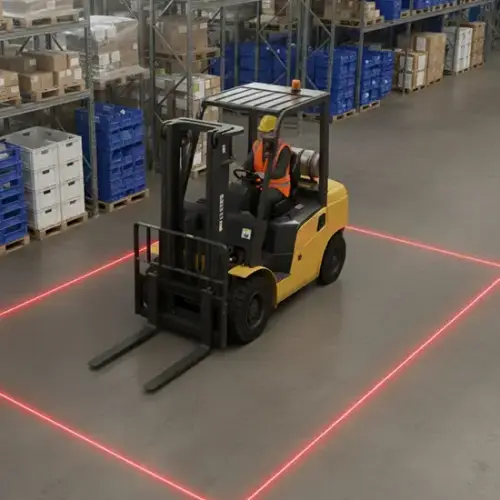
Halo Light Systems
Advantages:
- Visual warning for pedestrians
- No wearable components required for pedestrians
- Simple, inexpensive installation on existing equipment
Limitations:
- Puts the onus on pedestrians to see the halo and stay away
- Can give machine operators a false sense of security
- No data collection for safety improvement
- Often requires additional systems for comprehensive protection
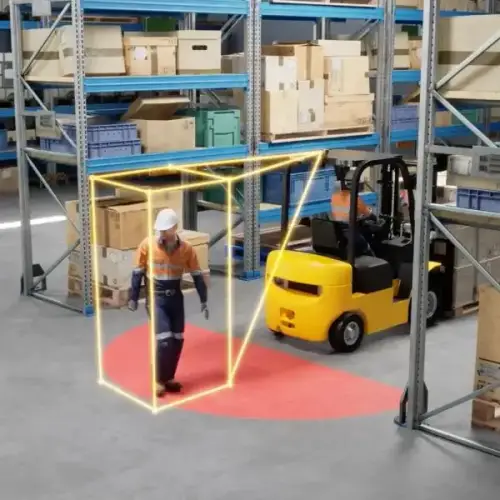
AI Camera-Based Systems
Advantages:
- Accurate detection without requiring wearable tags
- Fewer false alerts; less ‘alert fatigue’ than RFID systems
- Works effectively in all lighting conditions
- Captures valuable safety metrics and near-miss data
- ‘Always on’ solution that works whenever the machine is powered up
Limitations:
- Slightly higher initial investment (though lower total cost of ownership)
- Installation requires initial setup and calibration
- Camera placement must be optimised for comprehensive coverage

Industry-Specific Pedestrian Safety Solutions
Forklift Safety in Warehouse, Logistics & Distribution Centres
Warehouses present unique pedestrian safety challenges with their combination of high-speed forklifts, narrow aisles, and time-sensitive operations:
According to the Bureau of Labor Statistics, warehousing and storage facilities experience injury rates 30% higher than the national average for all industries, with transportation incidents being a leading cause.
Here’s why Proxicam is the leading solution for pedestrian safety in the warehouse:
- Superior Detection Accuracy: Class-leading 99.8% detection accuracy means fewer near misses and collisions, and fewer false alarms, reducing ‘alert fatigue’
- No Tags Required: RFID systems are useless if unauthorised visitors are present or a tag is forgotten or malfunctioning. Proxicam gets to work as soon as the machine powers up
- Continual Safety Improvement: DV Hub gives you complete visibility of all incidents and near misses, with video and telematics data available on an easy to use reporting dashboard
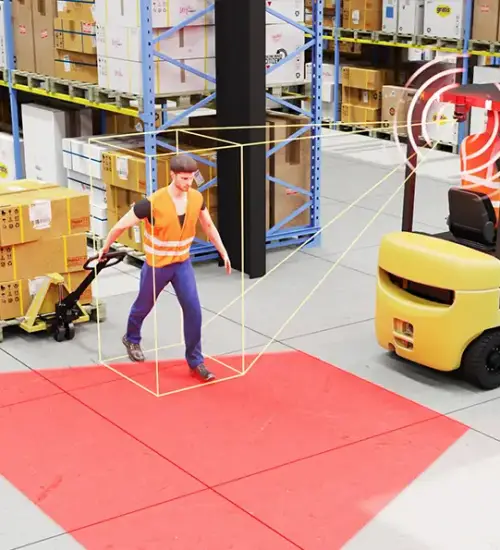
Pedestrian Safety for Mining Operations
Mining environments combine harsh conditions, massive equipment, and severely limited visibility.
The Mine Safety and Health Administration (MSHA) reports that powered haulage incidents remain one of the leading causes of mining fatalities, with nearly 50% involving the interaction between vehicles and pedestrians.
Proxicam is the ideal choice to ensure pedestrian safety on mining sites:
- Heavy Equipment Detection Capability: Up to four cameras can be installed and configured on haul trucks, loaders, and other mining equipment with extensive blind spots.
- All-Weather Performance: Ruggedised cameras, IP69K rated to function in dust, extreme temperatures, and challenging lighting conditions
- Underground Mine Safety: Designed for the unique challenges of underground operations, including low-light detection capability
- Continual Safety Improvement: Get valuable insights into pedestrian proximity events and asset telemetry data locally or via the cloud for continual learning and improvement
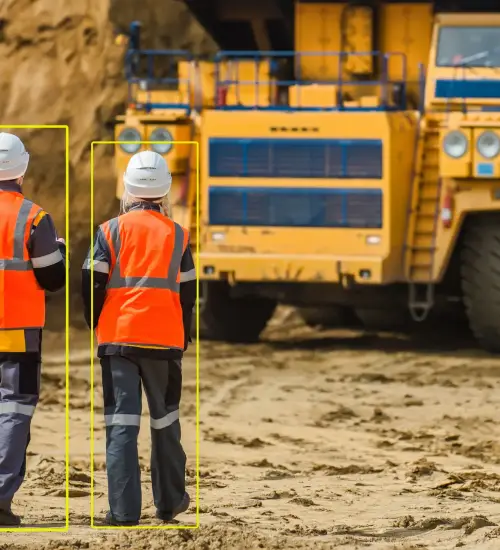
Pedestrian Safety on Construction Sites
The dynamic, ever-changing nature of construction sites creates distinct safety challenges.
According to the Center for Construction Research and Training, injuries from construction vehicles and heavy equipment account for nearly 15% of all construction fatalities.
Proxicam is designed for heavy construction machinery:
- Modular Design: Flexible enough to work across virtually any construction heavy equipment from trucks to cranes, excavators, rollers and more
- Eliminates Blind Spots: Employ up to four cameras to provide 360˚ coverage, with visual and audible alerts of pedestrian proximity no matter how big the blind spot
- Rugged by Design: IP69K rated to withstand the harshest conditions, day in, day out.


Why Proxicam’s AI-Powered Camera System Leads the Industry
Our AI camera-based pedestrian detection technology represents the cutting edge of pedestrian safety solutions:
More Targeted Pedestrian Alerts – Less ‘Alert Fatigue’
Unlike RFID systems that simply react to proximity (and generate many false positives as a result), Proxicam alerts operators when pedestrians are detected in the exclusion zones tailored and configured for each machine.
Best In Class Pedestrian Detection Accuracy
With its advanced AI camera system and trained AI detection algorithm, Proxicam has industry-leading 99.8% detection accuracy, meaning that more potential collisions are avoided, and fewer false alarms occur.
Delivers Actionable Safety Intelligence
Beyond immediate protection, our system collects comprehensive data on near-misses, incidents, and recurring risk zones. This intelligence allows safety managers to implement targeted improvements and build a continually improving safety culture.
Modular Design Works With Virtually Any Machine
From forklifts to mining dump trucks, excavators, scissor lifts and more, Proxicam is a flexible, modular system that can be installed on machines of all shapes and sizes. And with IP69K rating, it’s rugged enough to handle the most demanding environments.
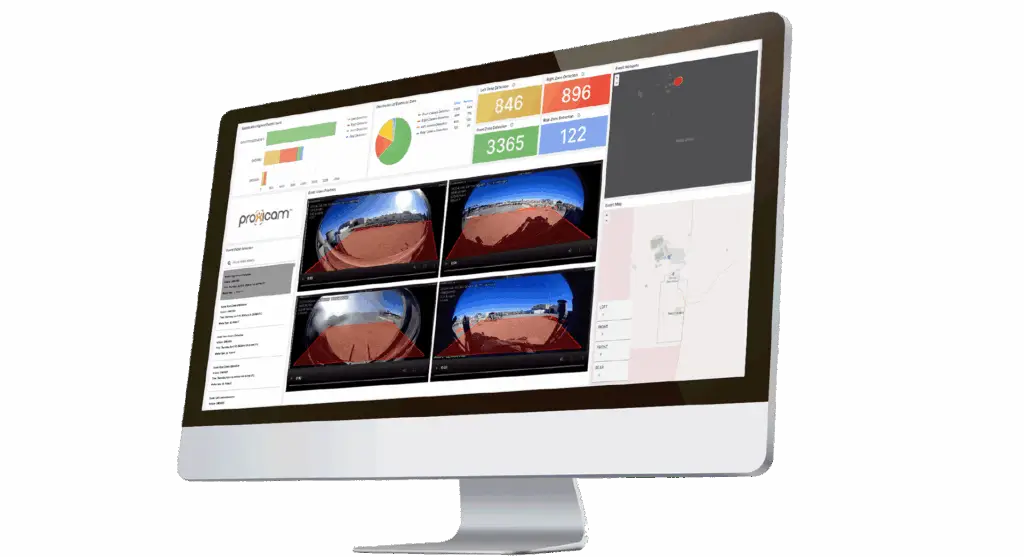
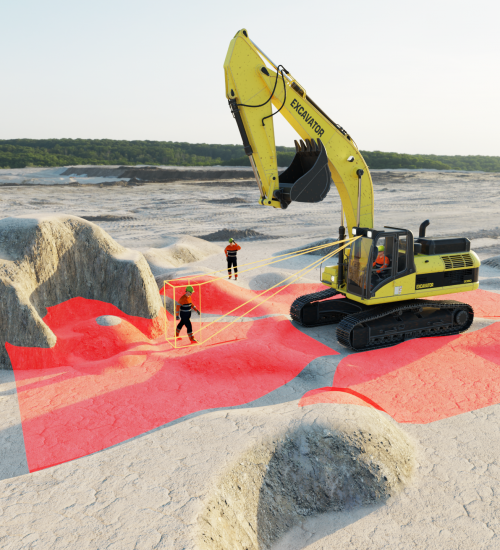

FAQ: Pedestrian Safety in the Workplace
What is the most effective forklift safety technology for preventing forklift-pedestrian incidents?
AI camera-based detection and alert systems offer the most comprehensive protection by identifying all pedestrians (with or without wearable tags), predicting collisions before they occur. AI-powered solutions actively monitor the environment and provide early warnings of pedestrians at risk while collecting valuable safety data such as video and telemetry to drive continuous improvement.
How do pedestrian detection systems compare cost-wise?
RFID systems:
- Tags need to be replaced when broken, lost or stolen.
- Batteries need to be charged daily which reduces the life span.
- Every employee and visitor needs to be equipped with one, adding to the cost.
AI Cameras:
- 1-2 cameras per machine can cover an entire warehouse, reducing the cost of supplying individual tags
- No ongoing costs once cameras are installed
How long does it take to install a pedestrian detection system?
Installation timeframes depend on facility size and system complexity. A typical AI camera-based system can be installed in 1-3 hours for a medium-sized warehouse with minimal disruption to operations. The process includes camera mounting, system calibration, alert mechanism installation, and operator training.
What maintenance is required for pedestrian detection systems?
AI camera-based systems require minimal maintenance compared to tag-based alternatives. Routine maintenance includes periodic lens cleaning, occasional software updates, and annual system calibration checks.
RFID pedestrian detection systems require routine maintenance to ensure reliable operation. This includes inspecting and testing hardware such as readers, antennas, and tags, as well as interference tests. Active tag systems require regular battery charging and/or replacement. Software should be updated regularly.
What safety regulations require pedestrian detection systems in warehouses?
In Australia, SafeWork Australia’s Model Code of Practice for Managing Risks of Plant in the Workplace establishes requirements for risk management relating to mobile plant and vehicles.
While not explicitly mandating detection systems, the hierarchy of control measures often leads to technological solutions when elimination of risks isn’t practical. The Work Health and Safety Act requires duty holders to ensure health and safety “so far as is reasonably practicable,” which increasingly includes implementing advanced safety technologies in high-risk environments.
For mining operations specifically, state-based regulations like the NSW Work Health and Safety (Mines and Petroleum Sites) Regulation 2014 contain provisions for proximity detection and collision avoidance technology. Similarly, Western Australia’s Mines Safety and Inspection Regulations address requirements for controlling risks associated with mobile equipment in mining operations.
In the US, while OSHA does not specifically mandate automated pedestrian detection systems, employers must comply with general duty obligations to provide workplaces “free from recognized hazards.” Several OSHA standards (1910.178 for powered industrial trucks) and ANSI/ITSDF B56.1 safety standards emphasise forklift safety. The International Organization for Standardization (ISO 3691) also provides international standards for powered industrial trucks, including safety requirements.
Many companies implement pedestrian detection systems to satisfy these regulatory requirements for adequate safeguards and demonstrate commitment to workplace safety best practices.
Take the Next Step in Workplace Safety
Ready to transform your approach to pedestrian safety? Contact our team today to find out more.
For more information on workplace safety standards and best practices, we recommend reviewing resources from these organisations:

